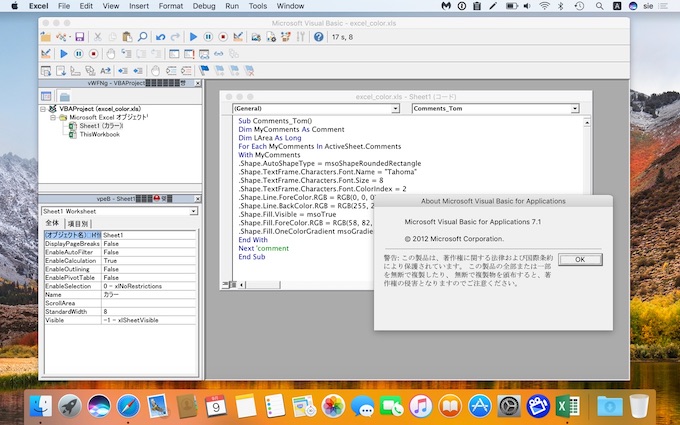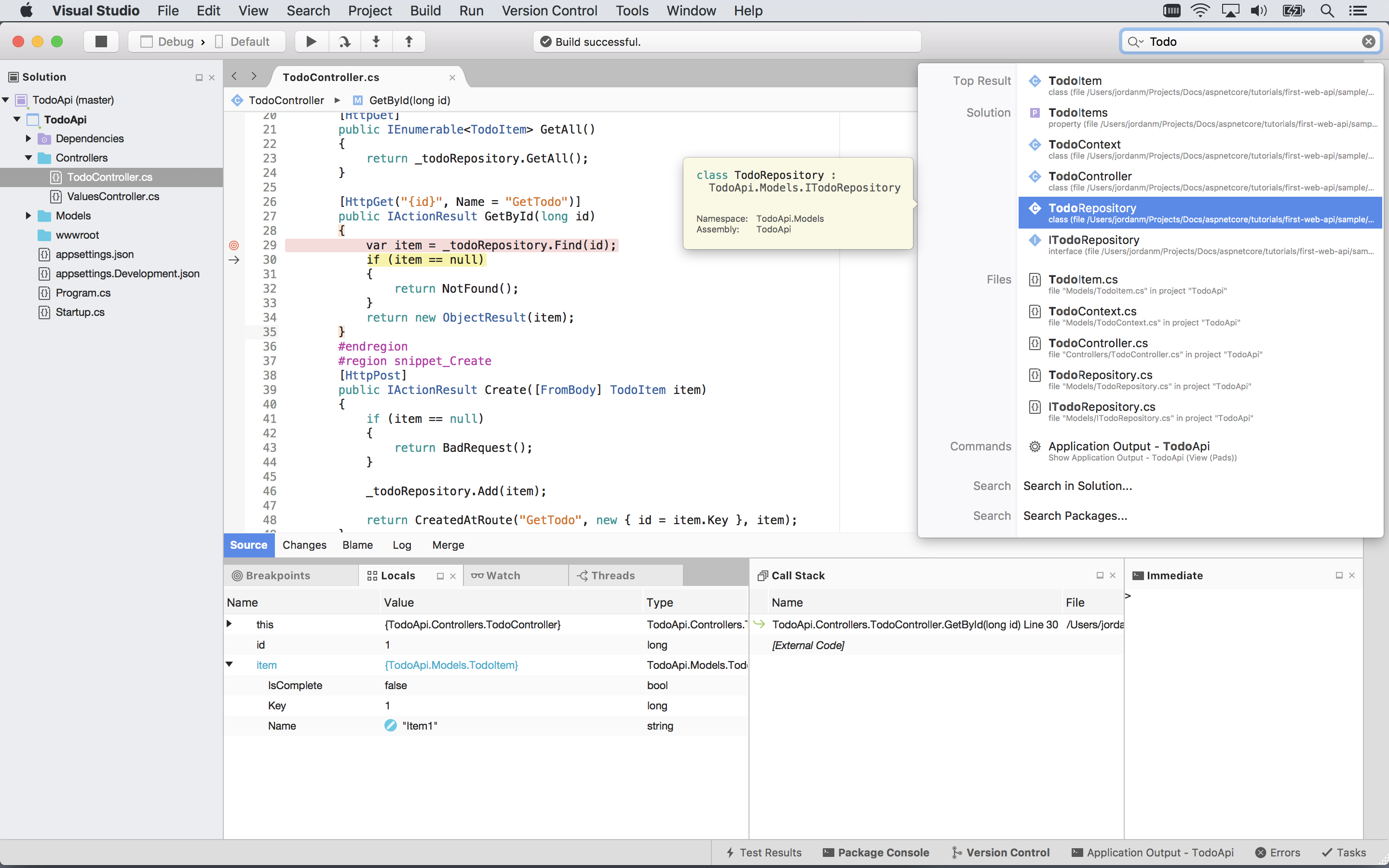Hands On Microsoft this week opened the gates on Visual Studio for Mac 2019 8.3, a flexible development environment for.NET, and The Reg can give you the lowdown on some of the new features. But first, let's see how the Microsofties got here. The Microsoft Office for Mac team shows you just how to deal with Visual Basic macros in this how-to video. Since Office 2008 removed support for Visual Basic macros, see one way to get around this limitation. After watching this video, you'll be able to:. Understand the limitation associated with Visual Basic macros in Excel 2008. Microsoft Visual Basic 6 0 For Mac free download - Learn Visual Basic 6, Microsoft Visual Basic 6 Common Controls, Service Pack 6 for Visual Basic 6.0, and many more programs.
-->
You can use this guide to uninstall each component in Visual Studio for Mac individually by navigating to the relevant section, or you can use the scripts provided in the Uninstall Script section to uninstall everything.
Note
This information will only remove Visual Studio 2019 or 2017 for Mac from your machine. to uninstall Visual Studio Code, see this issue for details.
Uninstall Script
There are two scripts that can be used to uninstall Visual Studio for Mac and all components for your machine:
The following sections provide information on downloading and using the scripts.
This video shows you a hidden tool in Mac Word which allows you to open up a userform similiar to visual basic (a Microsoft application which isn't available. Microsoft Visual Basic is Microsoft's implementation of the VB.NET language and associated tools and language services. It was introduced with Visual Studio.NET (2002). Microsoft has positioned Visual Basic for Rapid Application Development. Visual Basic can be used to author both console applications as well as GUI applications.
Visual Studio for Mac and Xamarin script
You can uninstall Visual Studio and Xamarin components in one go by using the uninstall script.
This uninstall script contains most of the commands that you will find in the article. There are three main omissions from the script and are not included due to possible external dependencies. To remove this, jump to the relevant section below and remove them manually:
To run the script, do the following steps:
Right-click on the script and select Save As to save the file on your Mac.
Open Terminal and change the working directory to where the script was downloaded:
Make the script executable and the run it with sudo:
Finally, delete the uninstall script and remove Visual Studio for Mac from the dock (if it's there).
.NET Core script
The uninstall script for .NET Core is located in the dotnet cli repo
To run the script, do the following steps:
Right-click on the script and select Save As to save the file on your Mac.
Open Terminal and change the working directory to where the script was downloaded:
Make the script executable and the run it with sudo:
Finally, delete the .NET Core uninstall script.
Uninstall Visual Studio for Mac
The first step in uninstalling Visual Studio from a Mac is to locate Visual Studio.app in the /Applications directory and drag it to the Trash Can. Alternatively, right-click and select Move to Trash as illustrated in the following image:
Deleting this app bundle removes Visual Studio for Mac, even though there may be other files related to Xamarin still on the file system.
To remove all traces of Visual Studio for Mac, run the following commands in Terminal:
You may also want to remove the following directory containing various Xamarin files and folders. However, before you do you should be aware that this directory contains the Android signing keys. For more information refer to the section Uninstalling Android SDK and Java SDK:
Uninstall Mono SDK (MDK)
Mono is an open-source implementation of Microsoft's .NET Framework and is used by all Xamarin Products—Xamarin.iOS, Xamarin.Android, and Xamarin.Mac to allow development of these platforms in C#.
Warning
There are other applications outside of Visual Studio for Mac that also use Mono, such as Unity.Be sure that there are no other dependencies on Mono before uninstalling it.
To remove the Mono Framework from a machine, run the following commands in Terminal:
Uninstall Xamarin.Android
There are a number of items required for the installation and use of Xamarin.Android, such as the Android SDK and Java SDK.
Use the following commands to remove Xamarin.Android:
Uninstall Android SDK and Java SDK
The Android SDK is required for development of Android applications. To completely remove all parts of the Android SDK, locate the file at ~/Library/Developer/Xamarin/ and move it to Trash.
Warning
You should be aware that Android signing keys that are generated by Visual Studio for Mac are located in ~/Library/Developer/Xamarin/Keystore. Make sure to back these up appropriately, or avoid removing this directory if you wish to keep your keystore.
The Java SDK (JDK) does not need to be uninstalled, as it is already pre-packaged as part of Mac OS X / macOS.
Uninstall Android AVD
Warning
Microsoft Visual Basic For Applications Macros Disabled
There are other applications outside of Visual Studio for Mac that also use Android AVD and these additional android components, such as Android Studio.Removing this directory may cause projects to break in Android Studio.
To remove any Android AVDs and additional Android components use the following command:
To remove only the Android AVDs use the following command:
Uninstall Xamarin.iOS
Xamarin.iOS allows iOS application development using C# or F# with Visual Studio for Mac.

Use the following commands in Terminal to remove all Xamarin.iOS files from a file system:
Uninstall Xamarin.Mac
Xamarin.Mac can be removed from your machine using the following two commands to eradicate the product and license from your Mac respectively:
Uninstall Workbooks and Inspector
Starting with 1.2.2, Xamarin Workbooks & Inspector can be uninstalled from a terminal by running:
For older versions, you need to manually remove the following artifacts:
- Delete the Workbooks app at
'/Applications/Xamarin Workbooks.app' - Delete the Inspector app at
'Applications/Xamarin Inspector.app' - Delete the add-ins:
'~/Library/Application Support/XamarinStudio-6.0/LocalInstall/Addins/Xamarin.Interactive'and'~/Library/Application Support/XamarinStudio-6.0/LocalInstall/Addins/Xamarin.Inspector' - Delete Inspector and supporting files here:
/Library/Frameworks/Xamarin.Interactive.frameworkand/Library/Frameworks/Xamarin.Inspector.framework
Uninstall the Xamarin Profiler
Uninstall the Visual Studio Installer
Use the following commands to remove all traces of the Xamarin Universal Installer:
Uninstall Visual Studio 2019 for Mac Preview
Visual Studio 2019 for Mac Preview was launched as a separate preview, allowing you to continue to work with your Visual Studio 2017 for Mac install side-by-side.
Now that Visual Studio 2019 for Mac has been released, you can now safely remove the Visual Studio 2019 for Mac Preview application.
To uninstall the preview application bundle, select Visual Studio (Preview) from your Applications folder and click Move to Trash, as depicted in the following image:
You can also remove the Preview plist file with the following command:
See also
Microsoft today announced that Visual Studio 2019 for Windows and Mac has hit general availability — you can download it now from visualstudio.microsoft.com/downloads. Visual Studio 2019 includes AI-assisted code completion with Visual Studio IntelliCode. Separately, real-time collaboration tool Visual Studio Live Share has also hit general availability, and is now included with Visual Studio 2019.
Microsoft launched Visual Studio 2017 in March 2017 and Visual Studio 2017 for Mac in May 2017, which turned out to be the “most popular Visual Studio release ever.” The company announced Visual Studio 2019 for Windows and Mac in June, and started releasing Visual Studio 2019 previews in December.

Visual Studio 2019 improves on Visual Studio 2017 across the board. It includes a new start window experience to get developers into their code faster (making it simpler to clone a Git repo or to open an existing project or folder), improved template selection screen, increased coding space, a new search experience, more refactoring capabilities, a document health indicator, and smarter debugging. Plus, all of the above works with both your existing project and new projects — from cross-platform C++ applications, to .NET mobile apps for Android and iOS written using Xamarin, to cloud-native applications using Azure services.
New features
The new start window on launch is designed to work better with today’s Git repositories, including local repos, Git repos on GitHub, and Azure Repos. Git aside, you can still open a project or a solution or create a new one of either.
Visual Studio’s UI and UX have also received subtle changes, such as a new product icon, a cleaner blue theme, and a more compact title and menu bar. There’s also a new search experience that replaces the Quick Launch box. It lets you find settings and commands and install options, and it even supports fuzzy string searching.
Visual Studio 2019 improves the code maintainability and consistency experiences with new refactoring capabilities — such as changing for-loops to LINQ queries and converting tuples to named-structs. There’s also a new document health indicator and code clean-up functionality.
As for debugging, stepping performance is improved and search capabilities have been added to the Autos, Locals, and Watch windows. You can also expect improvements to the Snapshot Debugger to target Azure Kubernetes Service (AKS) and Virtual Machine Scale Sets (VMSS), and better performance when debugging large C++ projects, thanks to an out-of-process 64-bit debugger.
IntelliCode and Live Share
At its Build 2018 developers conference in May, Microsoft previewed IntelliCode and Live Share. The former uses AI to offer intelligent suggestions that improve code quality and productivity, and the latter lets developers collaborate in real time with team members who can edit and debug directly from Visual Studio and Visual Studio Code.
Visual Studio IntelliCode now has custom models and expanded language support. Custom models further improve the AI-enhanced IntelliSense, giving developers personalized recommendations based on the patterns and libraries used in their code, on top of the analysis made on thousands of open source repos. Visual Studio developers now get IntelliCode for XAML and C++ code, in addition to C#. Visual Studio Code developers can use IntelliCode when developing JavaScript, TypeScript, Python, and Java.
Visual Studio Live Share, which is now installed by default in Visual Studio 2019, helps developers collaborate in real time, including desktop app sharing, source control diffs, and code commenting. Being able to share, edit, and debug code is great, but being able to do so without needing to clone repos or set up environments is even better. Based on feedback, Microsoft also added features like read-only mode, support for additional languages like C++ and Python, and enabled guests to start debugging sessions. Live Share can be used in a variety of use cases, including pair programming, code reviews, giving lectures, presenting to students and colleagues, or even mob programming during hackathons.
Learning Visual Studio 2019
For a full run-down of all the additions and improvements, check out what’s new, the docs, and release notes (Windows, Mac). Furthermore, Pluralsight has a free Visual Studio 2019 course available until April 22, while LinkedIn Learning has a free course available until May 2.
Microsoft Visual Basic 6.0 For Mac
Microsoft is also hosting a virtual Visual Studio 2019 Launch Event and over 70 local launch events around the world today where it will demo the new version and detail its features. The company has also planned over 200 more events between now and the end of June. If all else fails, there’s always the Visual Studio Developer Community.